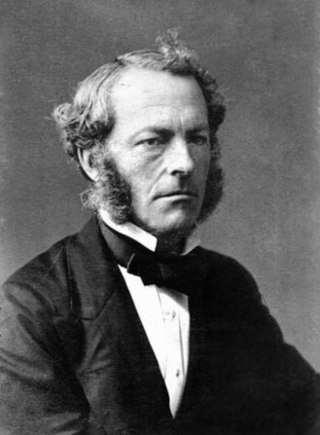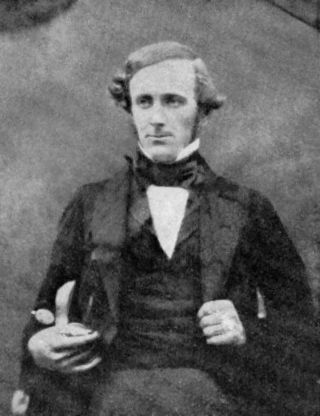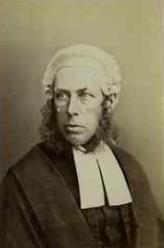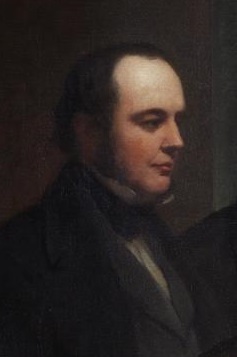
Sir John Frederick William Herschel, 1st Baronet was an English polymath active as a mathematician, astronomer, chemist, inventor, and experimental photographer who invented the blueprint and did botanical work.

The Cavendish Laboratory is the Department of Physics at the University of Cambridge, and is part of the School of Physical Sciences. The laboratory was opened in 1874 on the New Museums Site as a laboratory for experimental physics and is named after the British chemist and physicist Henry Cavendish. The laboratory has had a huge influence on research in the disciplines of physics and biology.

Sir George Gabriel Stokes, 1st Baronet, was an Irish physicist and mathematician. Born in County Sligo, Ireland, Stokes spent all of his career at the University of Cambridge, where he was the Lucasian Professor of Mathematics from 1849 until his death in 1903. As a physicist, Stokes made seminal contributions to fluid mechanics, including the Navier–Stokes equations; and to physical optics, with notable works on polarization and fluorescence. As a mathematician, he popularised "Stokes' theorem" in vector calculus and contributed to the theory of asymptotic expansions. Stokes, along with Felix Hoppe-Seyler, first demonstrated the oxygen transport function of haemoglobin, and showed colour changes produced by the aeration of haemoglobin solutions.

Sir Joseph Norman Lockyer was an English scientist and astronomer. Along with the French scientist Pierre Janssen, he is credited with discovering the gas helium. Lockyer also is remembered for being the founder and first editor of the influential journal Nature.
The year 1870 in science and technology involved some significant events, listed below.
The British Science Association (BSA) is a charity and learned society founded in 1831 to aid in the promotion and development of science. Until 2009 it was known as the British Association for the Advancement of Science (BA). The current Chief Executive is Katherine Mathieson. The BSA's mission is to get more people engaged in the field of science by coordinating, delivering, and overseeing different projects that are suited to achieve these goals. The BSA "envisions a society in which a diverse group of people can learn and apply the sciences in which they learn." and is managed by a professional staff located at their Head Office in the Wellcome Wolfson Building. The BSA offers a wide variety of activities and events that both recognize and encourage people to be involved in science. These include the British Science Festival, British Science Week, the CREST Awards, Huxley Summit, Media Fellowships Scheme, along with regional and local events.

Sir William Huggins was a British astronomer best known for his pioneering work in astronomical spectroscopy together with his wife, Margaret.

Sir James Paget, 1st Baronet FRS HFRSE was an English surgeon and pathologist who is best remembered for naming Paget's disease and who is considered, together with Rudolf Virchow, as one of the founders of scientific medical pathology. His famous works included Lectures on Tumours (1851) and Lectures on Surgical Pathology (1853). There are several medical conditions which were described by, and later named after, Paget:

Arthur Charles Hamilton-Gordon, 1st Baron Stanmore was a Scottish Liberal Party politician and colonial administrator. He had extensive contact with Prime Minister William Ewart Gladstone.

Sir Edward Frankland, was an English chemist. He was one of the originators of organometallic chemistry and introduced the concept of combining power or valence. An expert in water quality and analysis, he was a member of the second royal commission on the pollution of rivers, and studied London's water quality for decades. He also studied luminous flames and the effects of atmospheric pressure on dense ignited gas, and was one of the discoverers of helium.

Robert Porrett Collier, 1st Baron Monkswell, was an English lawyer, politician and judge.

Sir Thomas Clifford Allbutt was an English physician best known for his role as president of the British Medical Association 1920, for inventing the clinical thermometer, and for supporting Sir William Osler in founding the History of Medicine Society.

Robert Henry Thurston was an American engineer, and the first Professor of Mechanical Engineering at Stevens Institute of Technology.

The Davy Medal is awarded by the Royal Society of London "for an outstandingly important recent discovery in any branch of chemistry". Named after Humphry Davy, the medal is awarded with a monetary gift, initially of £1000. Receiving the Davy Medal has been identified as a potential precursor to being awarded the Nobel Prize in Chemistry, with 22 scientists as of 2022 having been awarded the medal prior to becoming Nobel laureates, according to an analysis by the Royal Society of Chemistry.

Henry Newell Martin, FRS was a British physiologist and vivisection activist.

Sir Edward Ryan PC FRS was an English lawyer, judge, reformer of the British Civil Service and patron of science. He served as Chief Justice of Bengal from 1833–43.

Sir Charles Wentworth Dilke, 1st Baronet, was an English art patron, horticulturalist and Whig politician. He is best remembered as one of the chief promoters of the Great Exhibition of 1851.

John Browning was an English inventor and manufacturer of precision scientific instruments in the 19th and early 20th centuries. He hailed from a long line of English instrument makers and transformed the family business from one dealing in nautical instruments to one specialising in scientific instruments. Browning was particularly well known for his advances in the fields of spectroscopy, astronomy, and optometry.
Thomas Jodrell Phillips Jodrell was a nineteenth-century barrister, land-owner and philanthropist.
The Jodrell Chair of Physiology is a chair at University College London, endowed by Thomas Jodrell Phillips Jodrell in 1873. The chairs succeeded the previous chair in Anatomy and Physiology.